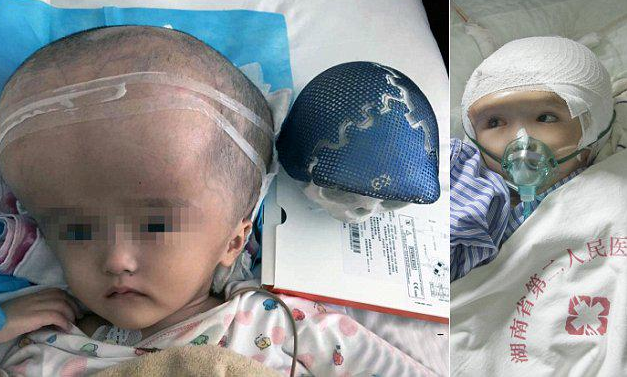Chinese Girl Becomes World's First To Receive Full Skull Reconstruction Via 3D Printing

A 3-year-old girl in China will finally be able to lift her head from the pillow after receiving the world’s first full skull reconstruction surgery via 3D printing technology. The toddler, referred to as “Han Han,” underwent 17 hours of surgery at the Second People’s Hospital of Hunan Province in China after suffering from a rare condition that caused her head to grow four times the normal size. The procedure, translated from Chinese as “whole brain shrinking plastic surgery,” involved a full 3D reconstruction and 3D printing of a new titanium skull to reposition her brain.
“CT results showed that Han Han’s brain was filled 80 percent with water,” said Dr. Bo of the Second People’s Hospital of Hunan Province, 3Dprint.com reported. “If she was not sent to hospital for treatment, Han Han would not have survived the summer. We had to first eliminate the infection in Han Han’s head because the brain wound area was too large, and we needed to do skin graft surgery and insert a shunt to help eliminate the infection, and remove the fluid from her brain.”
She was first diagnosed with congenital hydrocephalus at the age of 6 months. This type of hydrocephalus is present at birth and can either be caused by events or influences that occur during fetal development, or genetic abnormalities, according to the National Institute of Neurological Disorders and Stroke. Typically in congenital hydrocephalus, the cerebrospinal fluid (CSF) surrounds the brain and spinal cord. Excessive accumulation of CSF leads to abnormal widening of spaces in the brain called ventricles. This creates potentially harmful pressure on the tissues of the brain.
In infancy, the most notable symptom of hydrocephalus is a rapid increase in head circumference of an unusually large head size. For Han Han, the pressure of the excess fluid on the brain made her head weigh more than half her body weight, so much so she struggled to lift it from the pillow or get out of bed, the DailyMail reported. The toddler also developed medical problems, such as a thinning skull and poor blood supply. This prompted the family to take immediate action.
Baby becomes first person in the world to have 3D printed SKULL http://t.co/2vCj2moUtr pic.twitter.com/Rb81kajoCN
— Daily Mail Online (@MailOnline) July 16, 2015Chen Youzhi, Han Han’s father, was left to scramble for cash after the toddler’s mother left when she was 1 year old. Youzhi was able to collect 100,000 Chinese Yuan in donations from family and friends to meet the goal of 400,000–500,000 Chinese Yuan (approximately $64,000–$80,000) to pay for his daughter’s surgery. It was through online donations that Youzhi was able to get his daughter the life-saving surgery that would change her life.
Surgeons were able to use 3D data and a CT scanner to create models for 3D printing three titanium mesh skull implants that would together replace Han Han’s entire top portion of her skull. During the procedure, her scalp was peeled away from her skull and then attached to protective saline pads. Drainage tubes were then put in her head to slowly release the CSF. Lastly, the surgeons took the three 3D-printed titanium implants and inserted them into her head to recreate a new skull for her.
The world’s first 3D printer full skull reconstructive surgery was successfully completed once Han Han opened her eyes and was breathing before being transferred to the ICU for recovery. As she continues to grow, the titanium implants will become surrounded by her own bone, which will lead to the strengthening of the top of her skull. She is expected to make a full recovery.
3D printing has helped improve the lives of many infants like Han Han, including Gabriel Mandeville. The infant with epileptic seizures started to forget the fundamental things he was learning. Gabriel successfully underwent hemispherectomy treatment with a 3D-print brain replica to ensure his mental development and to help him become seizure-free.
The evolution of 3D printing has led the medical world to envision a new kind of future. Medical 3D printing began with devices such as hearing aids. Now there are 3D-printed implants, bone replacements, and soon human tissue. Advancements in 3D printing have helped change how people view medical illnesses.
Published by Medicaldaily.com



























